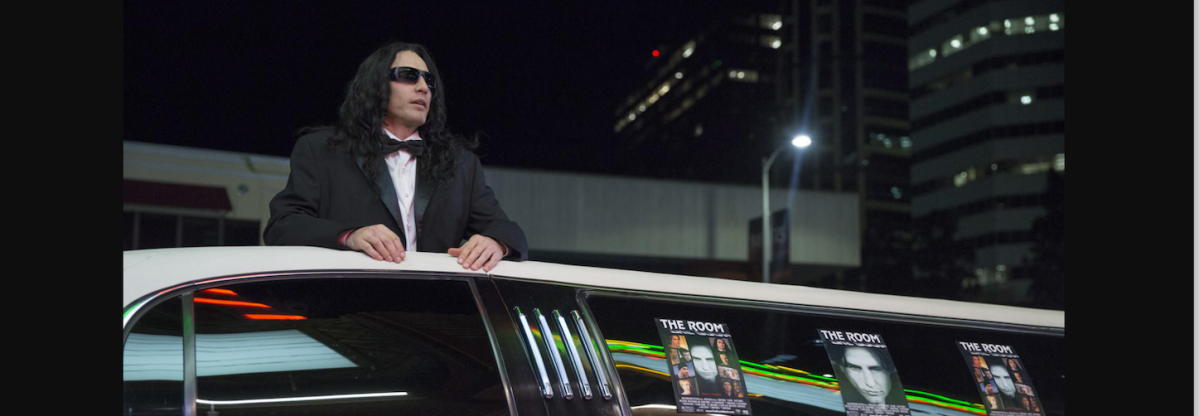There is something rotten at the core of The Disaster Artist, James Franco’s new film about the making of The Room, a modern cult classic in the “so bad it’s brilliant” vein. Spoiler alert: the toxic mess isn’t the movie itself, although, on several nights of rewatching the hilarious dumpster-fire of the self-funded movie written/directed/produced and starring the play-dough headed Tommy Wiseau, I started to feel a little slimy laughing at some of the movies more ridiculous themes. No, the putrescent reek of The Disaster Artist comes, much like The Room itself, from the singular brain of its creator, Tommy Wiseau. Piling on to this misogynistic sh-tshow is the obvious admiration and affinity to Wiseau felt by The Disaster Artist‘s director/star/producer James Franco, who, in his desire to find other multi-hyphenates like himself to showcase, has allowed himself to be suckered into buying Wiseau’s self-narrative as a true example of someone who, despite all odds, managed to achieve the American Dream.
What makes The Disaster Artist such a time-capsule of our current era is the fact that “the American Dream” is no longer obtained by pulling yourself up by your bootstraps, making sacrifices and becoming a success, but by being a paranoid millionaire whose money (an alleged $6 million of Wiseau’s own funds, with a $1,900 box office return) buys him the right to harass, abuse and physically harm the cast. (Despite his money, Wiseau is a tightwad when it comes to anything outside of his own self-interest and refuses to fix a generator in the middle of production, cause a grueling heatwave that eventually fells the older actress.) During the grueling six-month filming of The Room, Wiseau hired a cameraman to film his 400 and some employees during their downtime on the set, ostensibly for a behind-the-scenes “documentary.” As it turns out, Wiseau is actually watching the footage every night, essentially wire-tapping the entire production so he could hear whatever snarky comments were being said about him. Is this a man who we want on-stage at the Academy Awards alongside Franco giving a speech about the power of perseverance and unwavering vision?
The Room—and not to be confused with Brie Larson film—is full not only of flagrant disregard for the art of filmmaking, but an insidiously unhealthy view towards women in general. In the story, the female lead is “Lisa,” the “future-wife” of the all-American “Johnny” (played by the heavily-accented, clearly not American Wiseau) who forces Johnny into shooting himself in the head by seducing and sleeping with his best friend, “Mark.” (Mark is played by Greg Sestero, who co-wrote a book about the experience, off of which The Disaster Artist based its story and its name). Out of all the nonsensical parts of The Room—and there are many—Lisa’s motivations are the most irrational. She’s cruel for the sake of being cruel, a golddigger who lies about being assaulted by her future-husband (Wiseau hated foreign languages so much he banned the word “fiance” from the dialogue) because she’s bored, and is increasingly reviled by everyone in the film for her behavior … including her own mother. She’s called a b-tch, told that she can’t support herself repeatedly and is diagnosed by a dubious psychiatrist named Peter as being a sociopath.
Now, Lisa is truly a villainous character; it’s not like she’s getting a bum rap. But, to paraphrase Jessica Rabbit, Lisa can’t help it…she was written that way. The current theory and even floated in The Disaster Artist is that The Room is somewhat autobiographical and that Wiseau truly suffered a betrayal by his own versions of Lisa and Mark. But as Sestero tells Franco during an V magazine article, the “Lisa” character may be a McGuffin, trying to take the attention away possibly from Wiseau’s own sexuality:
Sestero: The Room is basically his life experience mixed with his view of life, of the ideal. I think he went through exactly what happened in it. I don’t know whether it was a girl, but somebody he trusted betrayed him. I think he always kind of saw me as somebody who may betray him.
This theory would at least lend some sympathy to Wiseau’s character, but The Disaster Artist seems less interested in mulling that over (perhaps because Wiseau keeps his past so secretive that it’s weird Buzzfeed hasn’t come out with a full-blown investigation into his history) and more in Wiseau’s relationship with Sestero, which is, somehow, even more jarring and creepy than that of Johnny and Lisa’s in The Room. After meeting in film class, the shy, introverted Sestero (played by Franco’s younger brother, a frosted-tips Dave Franco) approaches Wiseau to learn how to give an unencumbered performance. After that, things go from weird-funny to downright creepy, yet Franco managed to turn Wiseau back into the character we’re rooting for by the end of the film: the mercurial and meticulous iconoclast; the forever-misunderstood outsider on par with (at least in terms of temperament) Orson Welles, Stanley Kubrick and Hitchcock.
Sidenote: You can see the beginnings of this character dynamic between the Franco Brothers in the 2008 Funny or Die series, “Acting with James Franco.”
Now, The Disaster Artist does its part to show Wiseau as an anti-hero, warts and all. Much of the material in Sestero’s book is a disturbing glimpse into Wiseau’s possessive and jealous nature when it comes to their friendship, and the movie’s co-star keeps coming back to cinematic metaphors to describe their relationship after the much older Wiseau (who also won’t reveal his true age to anyone,) relocates the 19-year-old Sestero from his home in San Franciso to live with him in a Los Angeles studio apartment. Sestero invokes the dynamics in The Talented Mister Ripley and Sunset Boulevard, neither of which end well for its characters. (I’d also add Single White Female to that list.)
The Greek chorus of Wiseau’s duality of ridiculousness and psychotic instability comes in the form of the movie-with-the-movie’s script supervisor Sandy Schklair (Seth Rogen) and DP Raphael Smadja (Paul Scheer). “He knows where her vagina is, right?” an exasperated Sandy asks during the now-infamous bellybutton sex scene. Other situations are not so funny, as when Wiseau forces the humiliation of an open set during the aforementioned sex scene before openly berating his co-star for having too many pimples on her nude body. This is the one moment in the film where anyone’s reaction to Wiseau borders on appropriately enraged, as DP Raphael lashes out at the indignity of the scene and Wiseau’s cruel treatment of his co-star.
These moments are what saves The Disaster Artist, the commentary of the film distancing itself enough from the delusional and dangerous actions of its lead. As Wiseau, Franco cuts an imposingly jacked figure, and makes use of his hulking frame to intimate a furious and violent rage simmering just under the surface of the man. In one scene, Wiseau has a tantrum on the street over a perceived “betrayal” from Sestero; we see him picking up and hurling trash cans and mailboxes with the ease in which he tosses a football.
As a society, we’re fascinated by strange characters like the subject of The Disaster Artist’s. One could argue that history could not be made without men like Wiseau, shameless and, as Wiseau describes himself, “dictatorial.” But that doesn’t mean we have to celebrate them. In an era where we have to reconsider and recontextualize the films of our Hollywood heroes because their sense of untouchable entitlement led to years of secrecy and cover-ups of allegations of abuse, it feels unhealthily backward-looking to allow Franco to elevate Wiseau to a hero worth rooting for.
This article was featured in the InsideHook newsletter. Sign up now.
























